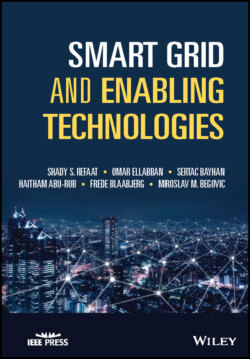Читать книгу Smart Grid and Enabling Technologies - Frede Blaabjerg - Страница 15
1.1 Introduction
ОглавлениеToday, power grids are being challenged to meet the ever‐growing energy demands of the twenty‐first century. Energy usage is projected to rise by 50% by 2050, according to the Energy Information Administration [1]. Today's grid is an aging infrastructure, combined with the growth of distributed energy resources (DERs), it is therefore more prone to outages and disturbances leading to poor reliability and power quality. These factors present a significant challenge for distributed renewable energy integration to the grid with unidirectional power flow [2]. The current grid is characterized by one‐directional electricity flow, lack of information exchange, centralized bulk generation, lack of flexibility to directly trade in electricity markets, inefficient monitoring and control of the power distribution networks, lack of flexibility and accessibility to new innovative solutions such as flexible loads, accommodating large scale of fluctuating energy resources, electric vehicles wide usage, etc. The SG is designed to tackle all these challenges by integrating and smartly utilizing the electricity, information, and communication infrastructures.
The SG is the solution to overcome the aforementioned challenges while also responding to the current and future humanity energy expectations. SG's implementation will not only have environmental benefits through high penetration of renewable sources, but will also have significant regional, national, and global impacts related to achieving a more reliable, efficient, and economic energy system. The SG paradigm integrates a variety of modern advanced technologies such as smart sensors and measurements, advanced communication and information, edge computing and control. This paradigm allows a flexible and reliable electricity system with bi‐directional power and information flows [3]. The structures of the SG anticipate and respond to electric system disturbances, optimize asset utilization, and operate efficiently. SG houses all generation and storage options, which hinders the dependency on peak demand back‐up power stations – thus, cutting significant costs related to the generation, transmission, and distribution. Furthermore, SG enables active participation of customers, new products, services, and markets – thus can support the uptake of new industries. SG functions resiliently against attacks and natural disasters, delivers power quality for the digital economy‐ thus, creating new jobs and regenerating the economy at a time of financial crisis. The SG is a power network that contains distributed nodes, which operate under the pervasive control of smart subsystems, so‐called smart microgrids. A microgrid is a small‐scale version of the electric grid, however possessing distributed generation and potentially energy storage (ES). Microgrids can operate in a grid‐connected mode, islanded mode, or in both modes which improve the grid's reliability, controllability, and efficiency. Widespread installations of microgrids enable a faster transformation to the SG paradigm from the current grid infrastructure [4].
